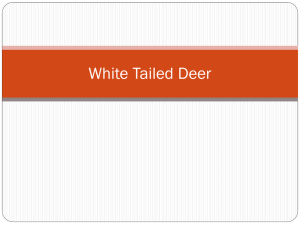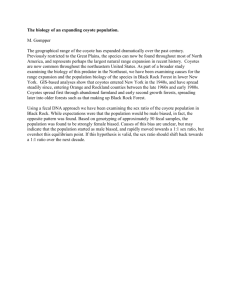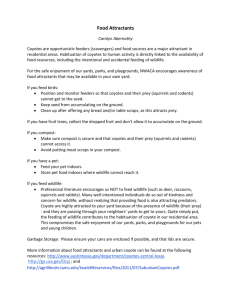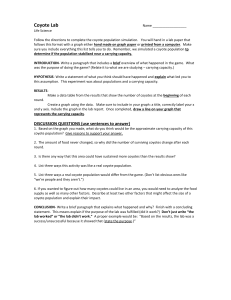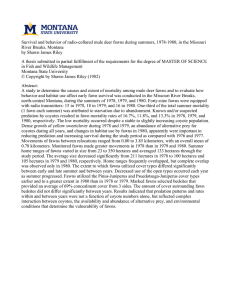A Model to Describe Coyote Diet Selection
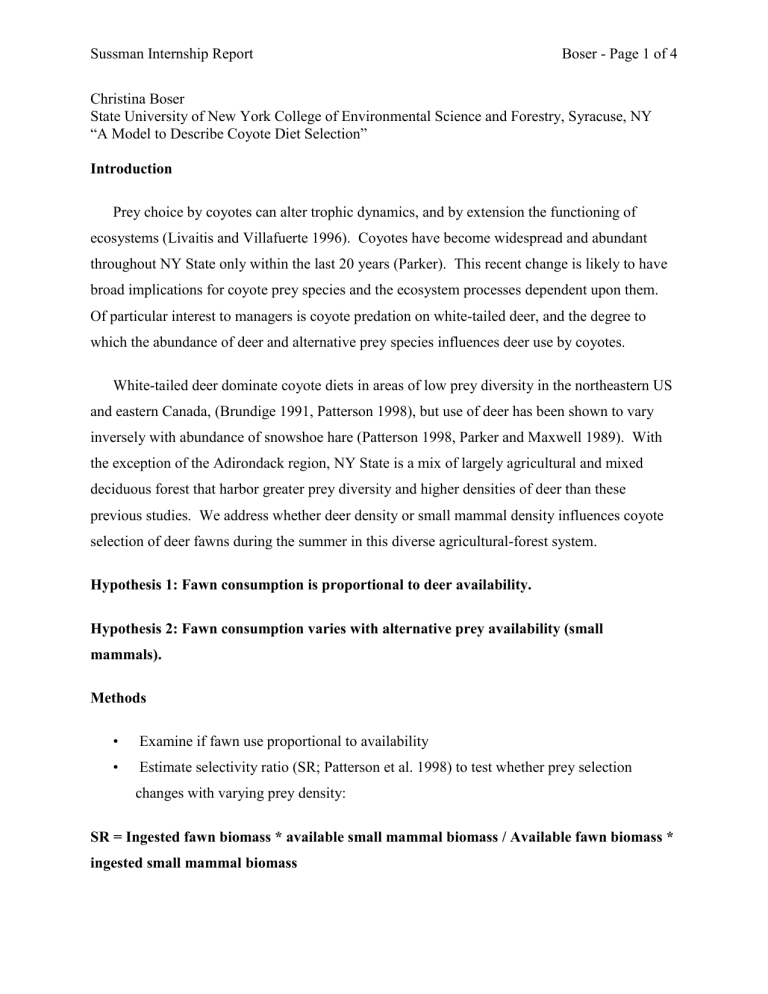
Sussman Internship Report Boser - Page 1 of 4
Christina Boser
State University of New York College of Environmental Science and Forestry, Syracuse, NY
“A Model to Describe Coyote Diet Selection”
Introduction
Prey choice by coyotes can alter trophic dynamics, and by extension the functioning of ecosystems (Livaitis and Villafuerte 1996). Coyotes have become widespread and abundant throughout NY State only within the last 20 years (Parker). This recent change is likely to have broad implications for coyote prey species and the ecosystem processes dependent upon them.
Of particular interest to managers is coyote predation on white-tailed deer, and the degree to which the abundance of deer and alternative prey species influences deer use by coyotes.
White-tailed deer dominate coyote diets in areas of low prey diversity in the northeastern US and eastern Canada, (Brundige 1991, Patterson 1998), but use of deer has been shown to vary inversely with abundance of snowshoe hare (Patterson 1998, Parker and Maxwell 1989). With the exception of the Adirondack region, NY State is a mix of largely agricultural and mixed deciduous forest that harbor greater prey diversity and higher densities of deer than these previous studies. We address whether deer density or small mammal density influences coyote selection of deer fawns during the summer in this diverse agricultural-forest system.
Hypothesis 1: Fawn consumption is proportional to deer availability.
Hypothesis 2: Fawn consumption varies with alternative prey availability (small mammals).
Methods
• Examine if fawn use proportional to availability
• Estimate selectivity ratio (SR; Patterson et al. 1998) to test whether prey selection changes with varying prey density:
SR = Ingested fawn biomass * available small mammal biomass / Available fawn biomass * ingested small mammal biomass
Sussman Internship Report Boser - Page 2 of 4
SR > 1 indicates selection for fawns, SR < 1 indicates selection for small mammals.
• Prey biomass ingested estimated from species occurrence in scats following Baker et al.
(1993). Scats collected Jun-Aug 2007-08 in Otsego and Steuben Counties, NY
• Deer density estimated using distance sampling, converted to fawn density using data on mean fawns conceived/female
• Small mammal density estimated using mark-recapture and track plate techniques (2008)
• Compare SR in early summer (June 1 - July 14), when fawns are most vulnerable, to late summer (July 15 - August 31)
Results
•
From 65-103 scats were analyzed per study area per period
•
A total of 15 prey items were detected in scats
•
Fawn consumption was higher at low fawn density, and reflected variation in small mammal density in Steuben
•
Fawn consumption did not consistently decrease with decreasing fawn vulnerability
• Selection for fawns was strong a low densities but was not apparent at high densities
Discussion
Coyote summer diet in the rural areas of New York State is extremely varied, deer fawns represent approximately 1/3 of the total biomass ingested, small prey approximately 1/3 and scavenged animals (livestock and adult deer) approximately 1/3. Coyotes ingested proportionally more fawns when fawn density was low, indicating that coyotes may seek out fawns as prey regardless of density thus we reject Hypothesis 1. Our data do not show that increased fawn vulnerability in early summer necessarily increases fawn use by coyotes. A wide variety of alternative prey items and the high availability of livestock and deer carcasses may offset fawn use during this time. Therefore, coyote predation on fawns may be inconsistent with either fawn density or vulnerability.
Coyote select fawns over small mammals when fawn density is low. There is no selection for fawns when fawn density is high, instead coyotes may select for small mammals when density is
Sussman Internship Report Boser - Page 3 of 4 low. In Steuben 2007 high use of small mammals under high densities reduced fawn consumption in comparison to 2008 when small mammal densities were low and fawn density remained constant. This demonstrates prey switching between fawns and small mammals and we accept Hypothesis 2.
Differences in prey habitat selection may influence coyote foraging behavior. Small mammal density was higher in forested plots, while fawn predation occurred predominantly in fields (R.
Holevinski, unpublished data). Thus, coyotes may increase predation success by switching foraging behavior and habitat selection in response to prey densities. Ongoing research is focused on coyote movements and habitat use in response to prey densities and landscape heterogeneity.
Management Implications
Coyote use of fawns is not proportional to availability but is impacted by alternative prey densities and the availability of supplemental food items (livestock carcasses). This coyote predation strategy may destabilize deer populations as deer density decreases but use of fawns remains constant.
Acknowledgments
I am grateful for the opportunity the Edna Bailey Sussman Foundation gave me by financially supporting this internship. During the internship period, I completed the field research component of my thesis project while learning from the staff at the DEC and the experience as a whole. Thank you!
Literature Cited:
Baker et al. (1993) Proc. 47th Annu. Conf. Southeast. Fish Wildl. Agencies, 47:71-79
Brundige (1993) Ph.D. thesis, SUNY-ESF, Syracuse;
Livaitis and Villafuerte (1996) Cons. Bio.
10:676-677
Parker and Maxwell (1989) Can. Field-Nat.
108:484-487
Parker (1995) Eastern coyote. Nimbus Publishing Limited, Halifax
Patterson et al. (1998) Can. J. Zool.
76: 1885-1897.
Sussman Internship Report Boser - Page 4 of 4
![[Clinic newsletter] - MSD Animal Health New Zealand](http://s3.studylib.net/store/data/007623488_2-57a0ccefba0719f75b5176091a508533-300x300.png)
